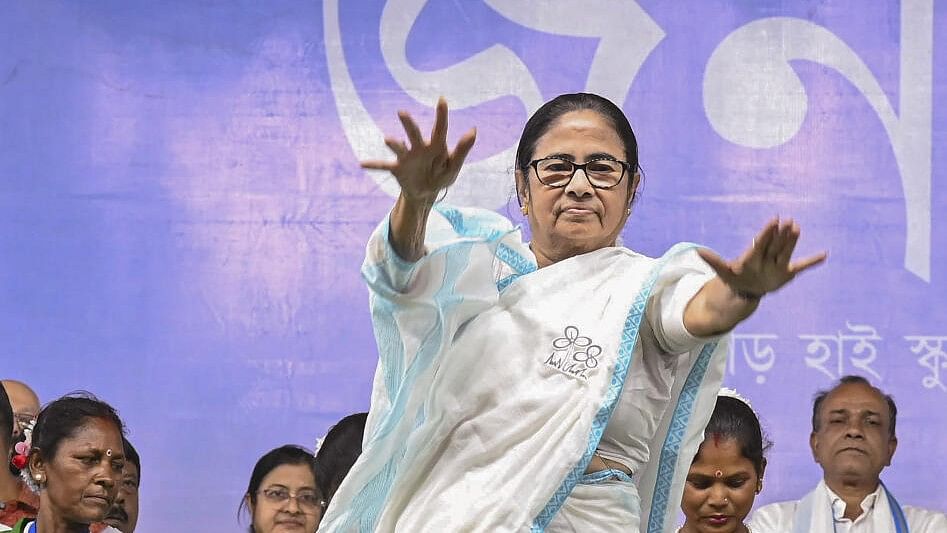
West Bengal Chief Minister Mamata Banerjee.
Credit: PTI Photo
West Bengal Chief Minister and Trinamool Congress chief Mamata Banerjee’s unpredictable zigzag course on her place inside (or outside) the slipshod partnership of the Indian National Inclusive Developmental Alliance (I.N.D.I.A.) has stirred up a storm of speculation on where she is headed and what are her intentions once the Lok Sabha polls conclude. The confusion stems from her two contradictory positions, declared on two consecutive days in public rallies in the southern part of West Bengal.
Her first statement, on May 15, that she would “do everything” to install an I.N.D.I.A. government in New Delhi if the Narendra Modi-led Bharatiya Janata Party (BJP) is defeated in the ongoing election but stay ‘outside’, came as a jolt. It contradicted her position reiterated over the past several months that she was a major stakeholder in the I.N.D.I.A. bloc, having assisted in the process of naming the new formation that emerged from the multiple rounds of consultations of the anti-BJP opposition in Patna, Bengaluru, and Mumbai.
Her second statement, on May 16, which is in the nature of a clarification, uses the usual dodge that she was ‘misinterpreted’. On May 17, Banerjee declared that she was going nowhere and was, as always, an insider in the I.N.D.I.A. bloc. She blamed the confusion on the misunderstanding of her position vis-à-vis the Congress and the CPI(M) in West Bengal’s internal politics, where the TMC is locked in battle with the Left, and occasionally goes through the motions of discussing an alliance with the Congress that invariably fall through.
There is no confusion on the state of the TMC’s rivalry with the Congress on the one hand and the CPI(M) on the other. The relationship has ranged from extreme hostility to just plain hate. In the 2021 assembly polls, and in the 2019 Lok Sabha polls, the relationship was extremely hostile, when the TMC on its part slotted the two parties as enemies along with the BJP. In the ongoing polls, the state of the relationship has changed; the BJP is the common enemy, though this does not alter the fact that the Congress and the CPI(M) are political rivals.
As a founder member of the I.N.D.I.A. bloc, Banerjee cannot distance herself from the entity that she helped establish. Her value in the bloc is based on the expectation that the TMC will scoop up more than the 22 Lok Sabha seats out of 42 that it won in 2019, and these victories will be at the cost of the BJP, which won 18 seats then. Her strength is the considerable influence she wields with smaller parties such as the Aam Aadmi Party (AAP) and even the Akhilesh Yadav-led Samajwadi Party (SP). Then there is the mystique that has grown around her as a redoubtable fighter.
An experienced and shrewd political leader, Banerjee is aware that staying outside the bloc should it win against the BJP is politically absurd. She and her party understand the value of being in power in New Delhi. The TMC was once an ally of the BJP government led by Atal Behari Vajpayee and then again an ally of the Congress in the United Progressive Alliance (UPA) government led by Manmohan Singh. The persona of Banerjee has become so fused with her role as chief minister over the past 13 years, that her earlier career as a Union minister of coal and railways, and her long years in the Lok Sabha have been forgotten.
Resorting to half-measures like ‘outside’ support is uncharacteristic of Banerjee. She is not encumbered by the ideological and organisational baggage that stopped the CPI(M) from joining the first UPA government in 2004, when it settled for a compromise by naming Somnath Chatterjee as Speaker of the Lok Sabha.
The CPI(M) in 2004 was offered the job of deputy prime minister, which it refused. By offering outside support, the CPI(M) had heft but no stake. Its decision to withdraw support to the Manmohan Singh government in 2008 over the civil nuclear deal contributed to its catastrophic defeat in the 2011 West Bengal elections against Banerjee’s TMC.
Refusing a chance at wielding power is incomprehensible to voters in West Bengal. Banerjee would be foolish to forget the price the CPI(M) paid by giving outside support, and then withdrawing it, since she knew exactly how to leverage her participation in the Singh government, and when to exit.
Her statement and immediate correction suggest that it was an exercise in checking the way the wind blows inside the I.N.D.I.A. bloc, and delivering a message to voters in West Bengal. The question is why did Banerjee need to deliver such a dramatic message?
Scenarios that suggest Banerjee is always precariously balanced on the fence and ready to jump over to join forces with the BJP can neither be confirmed nor denied. Local politics is awash with snippets of how the TMC is engaged in ‘setting’ things up — in other words, fixing elections in specific seats at every level. Any change in voter perception on this issue would impact the TMC in the ongoing election, and in the 2026 assembly elections.
Now, and two years later, the TMC’s target is the same: bleed the BJP to the point that it is marginalised, because a robust BJP is a threat to Banerjee and her legacy.
(Shikha Mukerjee Is a Kolkata-based senior journalist.)
Disclaimer: The views expressed above are the author's own. They do not necessarily reflect the views of DH.